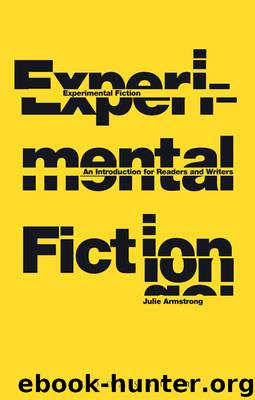Experimental Fiction by Armstrong Julie;

Author:Armstrong, Julie;
Language: eng
Format: epub
Publisher: Bloomsbury Publishing
Identity in Flux
In order that readers of experimental fiction can comprehend what the term ‘identity in flux’ means, this chapter explores the new representations of gender, the body and sexuality in postmodern fiction; it will also outline what can be attributed to these new representations in literary works, works that are deemed to be experimental, in terms of both form and content. Therefore, writers of experimental fiction will be able to explore these ‘new’ forms and content, as well as techniques and strategies, within their own work.
What has contributed to new perceptions of gender, the body and sexuality in the postmodern era?
Even as far back as 1949, Simone de Beauvoir’s The Second Sex claimed that gender, as distinct from biological sex, is a construct, something made by society, that is, one is not born a woman. If gender, then, is a construct and can be changed, manipulated and even performed, it can be viewed as a facet of a multiple, contradictory, fluid identity, one, that is, in flux.
Since the 1980s and 1990s, the world has become ever more complex and fluid; borders have fallen or have been crossed, access to the Internet has increased, so that individuals are learning to comprehend a multiplicity of view points and many ways of experiencing reality and identity. As Ian Gregson writes in Postmodern Literature, ‘ … a stable sense of identity has been persistently undermined’ (p. 41). It is a world where many of the old certainties, truths and beliefs have shifted, allowing individuals to experiment with their identities, sexualities and bodies. There is a plurality of opportunities to alter the body and its image: piercings, tattoos, body modification are readily available. Instead of identity being seen as something fixed and determined by social or cultural roles, it can be seen as something that can be constructed and reconstructed, leading to such questions as: What does it mean to be male? What does it mean to be female?
And so, the period of postmodernity has led to changes in the way gender, the body and sexuality have come to be perceived, with the self being viewed as a construct continually in process. Therefore, for readers and writers of experimental fiction, it is imperative to have an understanding, as to what has contributed to these changes.
Undoubtedly the rise of the Women’s Movement and other movements, notably Gay Pride, questioned gender assumptions. What were once constituted as gender norms has been called into question, leading to a newly fluid and unstable view of identity; this has been key to the cultural shift which marks the postmodern, a space where different voices can be heard. Where there was once a more clear definition of gender roles and gender spaces, both roles and spaces have now become blurred. More and more men are becoming homemakers, choosing to raise children, while women are taking on the role of breadwinner; therefore, concepts of gender roles have undergone a transition. In addition, with the acceleration of developments in technology and the
Download
This site does not store any files on its server. We only index and link to content provided by other sites. Please contact the content providers to delete copyright contents if any and email us, we'll remove relevant links or contents immediately.
4 3 2 1: A Novel by Paul Auster(11790)
The handmaid's tale by Margaret Atwood(7448)
Giovanni's Room by James Baldwin(6809)
Asking the Right Questions: A Guide to Critical Thinking by M. Neil Browne & Stuart M. Keeley(5356)
Big Magic: Creative Living Beyond Fear by Elizabeth Gilbert(5352)
Ego Is the Enemy by Ryan Holiday(4957)
On Writing A Memoir of the Craft by Stephen King(4663)
The Body: A Guide for Occupants by Bill Bryson(4583)
Ken Follett - World without end by Ken Follett(4443)
Bluets by Maggie Nelson(4261)
Adulting by Kelly Williams Brown(4234)
Eat That Frog! by Brian Tracy(4149)
Guilty Pleasures by Laurell K Hamilton(4116)
White Noise - A Novel by Don DeLillo(3829)
The Poetry of Pablo Neruda by Pablo Neruda(3815)
Fingerprints of the Gods by Graham Hancock(3738)
Alive: The Story of the Andes Survivors by Piers Paul Read(3730)
The Book of Joy by Dalai Lama(3697)
The Bookshop by Penelope Fitzgerald(3619)
